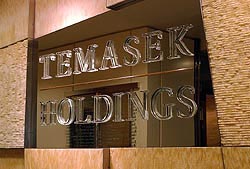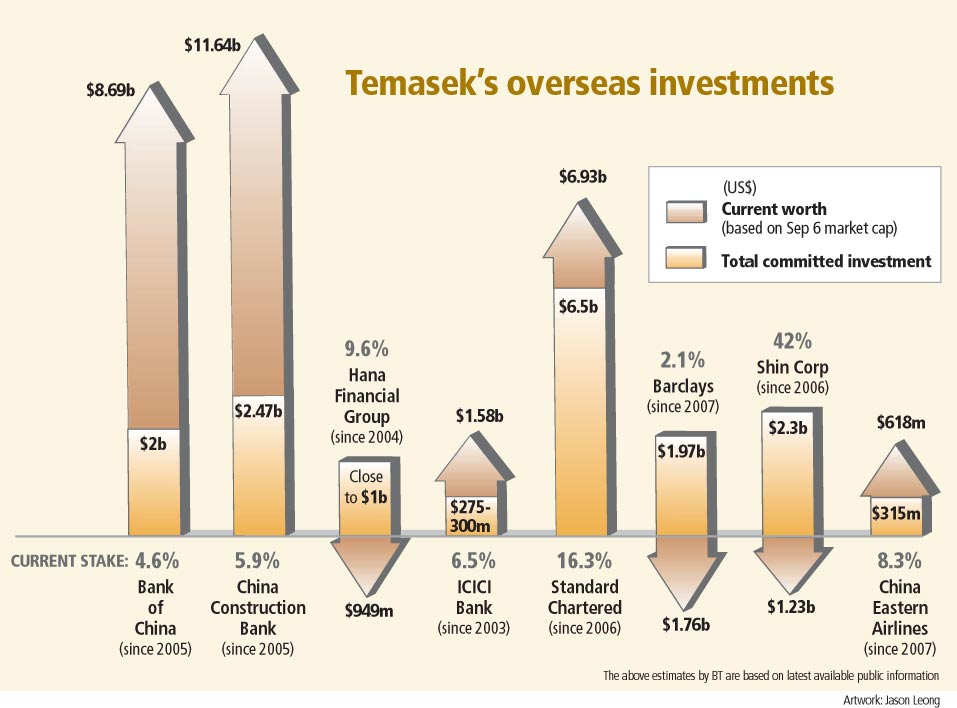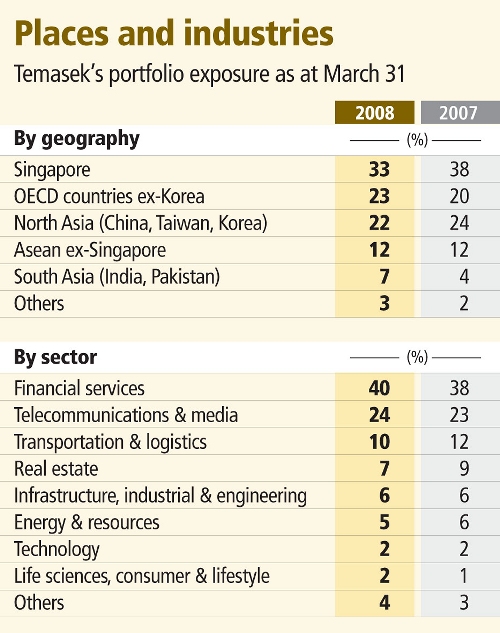|

 
Temasek,
GIC dominate world's largest SWF deals
The
S'pore units invest a combined US$9.1b, 47% more than a year ago
Temasek Holdings and the Government of
Singapore Investment Corp (GIC) have been involved in five of the 10 biggest
deals involving sovereign wealth funds on record, according to the latest
estimates by Thomson Reuters.
Singapore's two state-owned funds have
poured billions into US and European banks since last year. The sheer size
of their recent investments has surpassed many of the biggest purchases made
by sovereign wealth funds in the past.
GIC's injection of 11 billion Swiss
francs (S$14.24 billion) into Switzerland's biggest bank, UBS, last December
is the single largest investment by a sovereign fund on record, according to
data compiled by Thomson Reuters.
GIC was also part of the consortium led
by Spain's Ferrovial Group that bought UK-listed BAA, the world's biggest
airport operator, for £10.3 billion (S$26.7 billion) in May 2006. That
deal, which also included Canadian pension fund Caisse, still stands as the
largest investment involving sovereign funds on record.
So far this year, both GIC and Temasek
have made a combined US$9.1 billion worth of investments, more than a third
of all deals involving sovereign funds worldwide and a 47 per cent increase
from a year earlier, according to Thomson Reuters estimates.
The bulk of these investments were in the
US, the largest of which was GIC's US$6.88 billion investment in banking
giant Citigroup in January.
That was the single biggest investment by
any sovereign fund this year and the fourth largest on record.
GIC was also one of four investors in the
fifth-largest sovereign fund deal on record - a £2.5 billion takeover of
Associated British Ports, the UK's largest port operator, in March 2006.
GIC invests Singapore's foreign reserves
including pension savings, estimated at over US$300 billion, while Temasek
manages a separate S$185 billion investment portfolio.
Temasek's US$4.4 billion investment in US
investment bank Merrill Lynch last December is the 10th largest sovereign
fund deal on record. In January, two other sovereign funds, the Korea
Investment Corp and the Kuwait Investment Authority, each poured another
US$2 billion into Merrill.
Separately, Temasek invested £975
million in UK banking group Barclays in July last year. It is now likely to
raise its stake in Merrill to as much as 14 per cent from about 9 per cent,
after US regulators gave their approval this week (Aug 26).
Together, GIC and Temasek accounted for
10 of the 22 major deals involving sovereign funds this year, until Aug 28.
Investments by sovereign funds worldwide
rose 65 per cent to US$25.5 billion, from US$15.4 billion for the same
period last year, according to Thomson Reuters. -
2008 September 4 BUSINESS
TIMES
Temasek
warns of lean years as returns dwindle
(SINGAPORE) Temasek
Holdings has warned of a growing danger that global economic growth could
stall as the fallout from the credit crisis spreads around the world, with
possible stagflation posing a severe risk for years to come.
Temasek's own vast
portfolio of investments was buffeted by the turmoil that swept financial
markets since the start of the crisis last year.
By market value, the
total return to Temasek's sole shareholder - the Finance Ministry - for the
year to end-March fell to just 7 per cent, from 27 per cent a year earlier.
Economic profit or
wealth added - which Temasek uses internally to gauge its returns above a
risk-adjusted benchmark - was a negative $6.3 billion, the first time in
five years it fell below the cost-of-capital hurdle. A year earlier, wealth
added was $23.4 billion.
By one measure, the
market risk of Temasek's portfolio rose 67 per cent over the year to
end-March, reflecting the 'severe stress' in global financial markets,
according to its latest annual report.
Group net profit for
Temasek for the year to end-March doubled to a record $18.24 billion from a
year earlier, boosted by strong operating performance at its portfolio
companies and divestment gains from its asset sales.
Under standard
accounting rules, the consolidated net profit includes Temasek's share of
profits from companies in which it has a stake of 20 per cent or more, but
does not directly reflect its share of the profits or losses of firms in
which Temasek has a stake below 20 per cent. Profits from Singapore's DBS
Group, of which Temasek owns 28 per cent, would be included, while profits
from the UK's Standard Chartered Bank, in which Temasek has a 19 per cent
stake, would not.
'The credit crisis
is not over - we expect to see further contagion in the real economy in the
US, Europe and also Asia over the next 24 months,' said Temasek chairman S
Dhanabalan in the 2008 Temasek Review published yesterday.
The fallout from the
credit crisis 'will continue to dampen the global economy' for the next two
years, he added.
The 7 per cent
one-year return to the government - which includes dividends paid by Temasek
to the government net of new capital injections - is the lowest since
Temasek started publishing its annual report in 2004, when the return was 46
per cent.
Temasek's portfolio
performance over longer periods, however, remains strong, with compounded
annual returns of 23 per cent over five years, 9 per cent over 10 years, and
18 per cent since Temasek's inception in 1974.
But Mr Dhanabalan
was cautious on the outlook. 'We are concerned with the emerging risks of
stagflation. This presents huge socio-political as well as economic risks in
the next three to five years,' he said.
Bold policies by
regulators in the US had averted a major systemic failure, but 'the risks of
stagflation have become more apparent with the twin bogeys of high oil and
food prices', he added.
Still, 'there may be
opportunities as imbalances are corrected', although such opportunities may
be limited if stagflation - a period of stagnant economic growth coupled
with high inflation - does set in, he added.
During the year to
end-March, Temasek sold $17 billion worth of assets, including some $12
billion in Asia, 'as we anticipated a massive structural adjustment', said
Mr Dhanabalan.
In April last year,
Temasek also received an injection of new capital from the government, which
boosted its portfolio value by $10 billion, net of dividends paid to the
government. An undisclosed dividend amount is set yearly by the Temasek
board, said Michael Dee, Temasek senior managing director, international, at
a media briefing yesterday. Mr Dee, a former investment banker, recently
joined Temasek from Morgan Stanley. - 2008
August 27 BUSINESS
TIMES
Temasek stable hit by plunging markets
Half its investments in listed companies yield negative FY2008 returns
Many of Temasek's investments were poor
performers last year, giving negative returns, in line with plummeting
stockmarkets.
As measured by total shareholder return (TSR),
12 or half of its 24 investments in listed companies reported negative TSR
on a one-year basis.
Not surprisingly, six of the 12 with
negative one-year TSR were financial institutions, including homegrown DBS
Group Holdings which posted a negative TSR of 12.4 per cent.
Temasek's investments in financial
services make up 40 per cent of its total $185 billion portfolio.
Three of the 12 - Barclays plc, Merrill
Lynch and Chartered Semiconductor Manufacturing - had negative TSR on a
three-year basis. According to Bloomberg, Merrill shares have dropped 24 per
cent from the time of Temasek's original investment in December 2007 to
March 31, 2008.
At end-March, Barclays shares had
declined 38 per cent since Temasek and China Development Bank announced
plans to invest in the UK bank on July 23, 2007.
Temasek's investments in eight unlisted
companies fared much better with only one, MediaCorp, posting a negative TSR
of 5.1 per cent.
Temasek's TSR contracted to 7 per cent by
market value, including dividends for the year ended March 31, 2008, from 27
per cent a year ago.
But it wasn't just the banks which
performed poorly.
Non-financials Singapore Airlines,
CapitaLand, Sembcorp Industries, Chartered, STATS ChipPac and Fraser and
Neave also posted negative TSRs.
Other banks which reported negative TSR
included China's third largest bank, Bank of China; South Korea's Hana
Financial Group; and India's ICICI Bank.
Those in positive TSR territory were
Temasek's investments in China Construction Bank, Pakistan's NIB Bank,
Standard Chartered plc and the two Indonesian banks, Bank Danamon and Bank
Internasional Indonesia (BII).
NIB Bank, in which Temasek owns 63 per
cent, delivered the second-highest one-year TSR of 132.7 per cent. Temasek
bought into NIB in May last year. The Pakistani bank in 2007 posted a loss
of 204 million rupees (S$3.8 million).
BII, which Temasek had tried to sell to
Maybank but only to see the deal stall, posted the highest one-year TSR of
146.8 per cent.
Another sterling performer was Singapore
Telecommunications, Temasek's biggest investment with a 55 per cent stake.
SingTel, also Singapore's largest stock by market capitalisation, posted a
one-year TSR of 26 per cent.
Although SingTel's stock price has fallen
this month since it reported a 5.3 per cent drop in first-quarter profit for
the three months ended June 30, to a two-year low of $878 million, it is
still outperforming the market. Year-to-date, SingTel has fallen 13.25 per
cent, compared to the Straits Times Index's 21.9 per cent drop.
- 2008 August 27 BUSINESS
TIMES

Bet on Asia stays, but Temasek sheds
some assets
Temasek Holdings' focus on Asia has
reaped substantial rewards so far, even as it poured billions of dollars
into US and UK banks over the past year.
Investments made since 2002, when Temasek
reshaped its portfolio to boost its exposure to emerging Asia, earned an
annualised return of 32 per cent over the six years to end-March - double
the 16 per cent returns on the rest of its portfolio, said Michael Dee,
Temasek senior managing director, international, at a media briefing
yesterday.
Investments made since March 2002 now
make up 41 per cent of Temasek's $185 billion portfolio, he added.
Over the year to end-March, Temasek
invested just under $17 billion in Asia and another $15 billion outside the
region.
But it also divested more Asian assets
than non- Asian assets during the year - $12 billion compared with $5
billion.
Within Asia, Temasek trimmed its
portfolio exposure to North Asia to 22 per cent from 24 per cent, selling
its stake in China Cosco Holdings. Temasek also pared its stakes in other
major Chinese firms such as China Construction Bank and Bank of China.
But Temasek also boosted its exposure to
South Asia, buying a stake of 4.99 per cent in Indian mobile operator Bharti
Airtel for an estimated US$2 billion last year.
And in March this year, it sold Singapore
power generating company Tuas Power for $4.2 billion. That prompted a fall
in Temasek's portfolio's exposure to Singapore to 33 per cent as at
end-March, from 38 per cent a year earlier.
The large divestments in Asia meant that
for the first time, Temasek's net investments outside Asia exceeded net
investments in Asia, with 68 per cent or $10 billion outside Asia and the
remaining 32 per cent or $5 billion in Asia.
Its major forays outside Asia included a
US$4.9 billion investment into Merrill Lynch in the US and √ā¬£pounds;975
million (S$2.6 billion) in Barclays in the UK, both last year. It also
raised its stake in UK-based Standard Chartered Bank to 19 per cent from 13
per cent.
This contrasts starkly with the previous
five years, during which Temasek's total net investment outside Asia was
just $1 billion, while net investment in Asia was $26 billion.
But Temasek chairman S Dhanabalan said in
the 2008 Temasek Review published yesterday that the firm continues to like
Asia, even as it adds to its investments elsewhere.
'We will continue to broadly focus on
Asia with its long-term trend of growth and development in the next decade
or two.'

Temasek is also looking to increase its
exposure further afield, including new markets such as Russia and Latin
America, said Mr Dhanabalan. 'We are setting up offices in Mexico and Brazil
to deepen and broaden our exposure to Latin America.'
The firm has boosted its staff strength
to 350 over the past year, from 250 previously, and set up a new
international division that will oversee all of Temasek's overseas offices,
said Mr Dee. 'We're expanding our global footprint.'
Its recent investments in US and UK banks
were 'primarily because we saw value', said Manish Kejriwal, Temasek senior
managing director of investment, international and India.
Asked if Temasek was concerned over the
recent declines in the share prices of banks it had stakes in, Lao Tzu Ming,
managing director of risk management, said: 'Unlike short-term traders such
as hedge funds, we are not highly geared - therefore we can ride through the
storms.'
The portfolio remains well-diversified,
said Temasek. Its single largest investment accounts for less than 19 per
cent of its overall portfolio, down from 26 per cent five years earlier.
- 2008 August 27 BUSINESS
TIMES

|